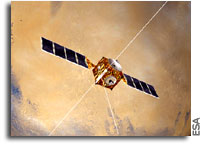CCSDS Proximity-1 Communications Protocol Enables High-Speed Communication at Mars

Proximity-1, a communications protocol developed by the international Consultative Committee for Space Data Systems (CCSDS), was instrumental in the success of a recent first-ever demonstration of in-orbit communication between NASA’s Mars Exploration Rover (MER) Spirit and European Space Agency (ESA) Mars Express (MEX) orbiter.
Proximity-1 is a short haul delivery protocol designed to establish a two-way communications link between a lander and an orbiter, negotiate data rate and communications mode, and reliably deliver data during short orbiter-to-surface contacts.
Supported by NASA, CCSDS is an international committee founded by the world’s major space agencies dedicated to furthering interoperability in space through the development of standardized techniques for handling space data. NASA’s Jet Propulsion Laboratory (JPL), working with its international partners in the CCSDS, led the development of Proximity-1.
On February 6, 2004, Proximity-1 performed flawlessly during the NASA and ESA sponsored demonstration of communications between the rover Spirit and MEX orbiter. The CCSDS protocol not only enabled the first in-orbit communication between NASA and ESA spacecraft, it also helped establish the first working international communications network around a planet other than Earth.
“I believe CCSDS protocols are the real ‘story behind the story’ of successful communications on the Mars missions,” said Peter Shames of NASA’s Jet Propulsion Laboratory (JPL), Pasadena, Calif. “Without them, trying to establish communication between the rovers and orbiters would be like trying to tune in an FM station on an AM radio.”
Prior to the development of CCSDS’ Proximity-1, earlier missions like Mars Pathfinder had to transmit data directly from the Martian surface back to Earth. With millions of miles between the two planets and Spirit’s limited transmitter, the maximum data transmission rate from Mars to Earth was approximately 22 Kbps. Also, despite error correcting codes, very weak signal levels meant data reliability was limited.
Mars mission planners had long recognized the advantage of transmitting data from lander to orbiter, then from orbiter to Earth. The distance from lander to orbiter is only a few hundred miles, allowing energy-efficient communications using simple omni-directional antennas. This means that signals received from the lander are stronger and have fewer errors. The orbiter, less constrained by power, is able to then re-transmit the data to Earth at a high rate.
Planners estimated that the rover’s data transmission rate using a shorter, Proximity-1-enabled communication path would be up to four times faster than one using a direct to Earth link. They also estimated data rates would be higher since Proximity-1’s reliability features allow the protocol to immediately fill any data gaps. Regardless, because the path was largely untested, planners were unwilling to make it the primary path of communication on the project, that is, until Proximity-1’s flawless performance on February 6th.
Today, utilizing CCSDS’ Proximity-1, MER rovers Spirit and Opportunity are reliably sending data to the Mars Odyssey orbiter at 256 Kbps, twice as fast as the planned maximum transmission rate. Further, scientists are receiving an average of three times more data than originally estimated and relay links enabled by Proximity-1 are responsible for over 90 percent of all of the data returned from the rovers.
“Communication between the Mars rovers and orbiters has been so successful because of CCSDS-developed protocols,” said Shames. “In fact, in recent years, all Mars spacecraft have implemented standard data communications protocols developed by CCSDS on their long-haul links back to Earth.”
Proximity-1, CCSDS’ most recent success, is the first space communications protocol to reliably operate in the proximate environment between a Mars bound asset and an orbiter. Coupled with long-haul CCSDS protocols already used to relay data from the orbiters back to Earth, CCSDS’ Proximity-1 is yet another sign of a new era of successful international cooperation in space.
CCSDS will move forward in supporting the efforts of NASA, ESA, and other space agencies in using joint communications assets in future missions to the surface of Mars and, as it has for more than 20 years, will continue to develop new protocols to further both commercial and governmental interoperability in space.
About the Consultative Committee for Space Data Systems
In 1982, the world’s major space agencies recognized that future data system interoperability would be enhanced through the development of standardized techniques for handling space data and established the Consultative Committee for Space Data Systems (CCSDS) as a forum where common space data system standards could be developed.
Over two decades later, CCSDS has grown into an organization of international cooperation and information-sharing comprised of 10 member agencies, 22 observer agencies and over 100 private industry associates from around the world. Data communications protocols developed by CCSDS now fly on over 280 international missions, including every spacecraft associated with the Mars mission.
For more information about CCSDS, please visit the CCSDS web site at http://www.ccsds.org.









